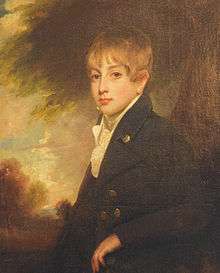Sir Charles Coote, 9th Baronet
Sir Charles Henry Coote, 9th Baronet (2 January 1794 – 8 October 1864)[1][2] was an Irish Conservative and Tory politician.[3][4][5]
Sir Charles Coote | |
|---|---|
 Portrait by John Hoppner, c. 1803 | |
| Member of Parliament for Queen's County | |
| In office 19 July 1852 – 10 May 1859 | |
| Preceded by | John FitzPatrick Thomas Vesey |
| Succeeded by | Michael Dunne Francis Plunkett Dunne |
| In office 27 August 1821 – 7 August 1847 Serving with Thomas Vesey (1841–1847) John FitzPatrick (1837–1841) Thomas Vesey (1835–1837) Patt Lalor (1832–1835) Henry Parnell (1821–1832) | |
| Preceded by | William Wellesley-Pole Henry Parnell |
| Succeeded by | John FitzPatrick Thomas Vesey |
| Personal details | |
| Born | 2 January 1794 |
| Died | 8 October 1864 (aged 70) |
| Nationality | Irish |
| Political party | Conservative/Tory |
Family and early life
Coote was the son of Chidley Coote of Ash Hill, County Limerick, and Elizabeth Anne née Carr. Educated at Eton College (leaving in 1805) and Trinity College, Cambridge (leaving in 1809), he married Caroline Whaley (daughter of John Whaley) in 1814. They had five sons and two daughters, including: Charles Henry (1815–1895); John Chidley (1816–1879); Algernon (1817–1899); Caroline (1819–1848); Robert (1820–1898); and Chidley Downes (1829–1872).[4][5]
Baronetcy
A distant descendant of Sir Charles Coote, 1st Baronet, he succeeded to the Coote baronetcy in 1802 upon the death of Charles Coote, 7th Earl of Mountrath. Upon his own death in 1864, the title passed to his eldest son, Sir Charles Henry Coote, 10th Baronet.[2][4][5]
Member of Parliament
While he initially stood unsuccessfully in 1818 and 1820, Coote was first elected Tory MP for Queen's County at a by-election in 1821—caused by the elevation of William Wellesley-Pole to Lord Maryborough—and, becoming a Conservative in 1834, held the seat until 1847, when he did not seek re-election. During this period, he was known as a lax attender, and he generally divided with the Tory leader Lord Liverpool, occasionally siding with the Whigs on matters such as the abolition of joint-postmasterships and inquiries into the borough franchise.[4][3]
He returned at the next election in 1852 and held the seat until 1859 when he, again, did not seek re-election.[3][4]
References
- Rayment, Leigh (13 June 2017). "The House of Commons: Constituencies beginning with "Q"". Leigh Rayment's Peerage Page. Archived from the original on 7 October 2018. Retrieved 7 October 2018.
- Rayment, Leigh (23 May 2018). "Baronetcies beginning with "C"". Leigh Rayment's Peerage Page. Archived from the original on 7 October 2018. Retrieved 7 October 2018.
- Walker, B.M., ed. (1978). Parliamentary Election Results in Ireland, 1801–1922. Dublin: Royal Irish Academy. pp. 236, 308–309. ISBN 978-0901714121.
- Salmon, Philip. Fisher, D. R. (ed.). "COOTE, Sir Charles Henry, 9th bt. (1794–1864), of Ballyfin, Mountrath, Queen's Co". The History of Parliament. Retrieved 7 October 2018.
- Lundy, Darryl (17 February 2011). "Sir Charles Henry Coote, 9th Bt". The Peerage. Archived from the original on 7 October 2018. Retrieved 8 October 2018.
External links
- Hansard 1803–2005: contributions in Parliament by Sir Charles Coote
| Parliament of the United Kingdom | ||
|---|---|---|
| Preceded by William Wellesley-Pole Henry Parnell |
Member of Parliament for Queen's County 1821–1847 With: Thomas Vesey (1841–1847) John FitzPatrick (1837–1841) Thomas Vesey (1835–1837) Patt Lalor (1832–1835) Henry Parnell (1821–1832) |
Succeeded by John FitzPatrick Thomas Vesey |
| Preceded by John FitzPatrick Thomas Vesey |
Member of Parliament for Queen's County 1852–1859 With: Michael Dunne |
Succeeded by Michael Dunne Francis Plunkett Dunne |
| Baronetage of the United Kingdom | ||
| Preceded by Charles Coote |
Baronet (of Castle Cuffe) 1802–1864 |
Succeeded by Charles Henry Coote |